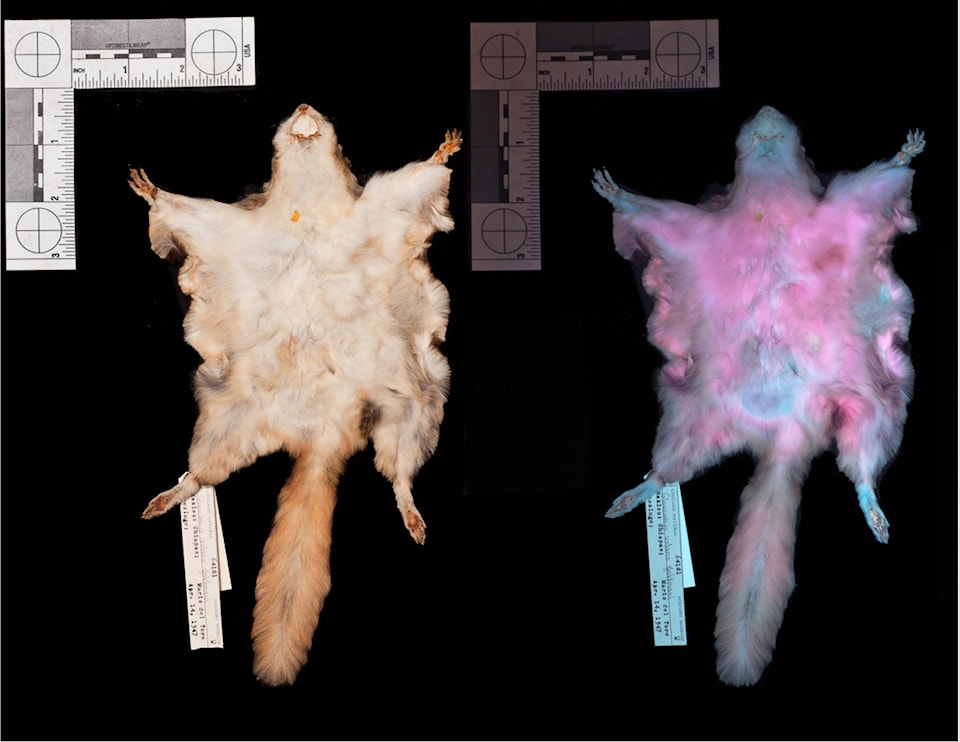Is an ultraviolet flashlight part of your camping kit? If not, you may want to get one. Scientists in Wisconsin have just discovered that flying squirrels, including two specimens from B.C., are vividly fluorescent under UV light.
Skeptical? At first, so were the colleagues of Wisconsin-based biologist Jonathan Martin, who stumbled upon the splendorous squirrels in his own backyard.
Martin told Black Press Media it all started when the worldãs first fluorescent frogs were discovered in the tropics in 2017.
Intent on finding out if the frogs in his woodsy backyard also fluoresce (they donãt), he purchased a UV flashlight.
Martin was outside with the flashlight, poking around in some of the surrounding plant life, when he heard activity at his bird feeder.
ãWe have quite a few flying squirrels that come to the bird feeder and I just happened to be out there, heard it and didnãt even think that it was a UV light in my hand,ã said Martin, who instinctively turned toward the squirrels. ãI was like, ãHoly smokes!ãã
Under the UV light, the flying squirrels were fluorescing pink.
ãThe pictures donãt do it justice,ã said Martin. ãItãs bright pink. Itãs neon pink.ã
Being a professor of forestry at Northland College in Wisconsin, or a ãtree guyã as he says, Martin was met with some skepticism when he told his mammal-specialized colleagues about the fuchsia fur.
But at Martinãs request, Northland natural resources professor Erik Olson took a UV flashlight along with him on a mammal trapping trip. Olson saw the rosûˋ rodents, then so did Northlandãs small animal expert Paula Spaeth Anich, and soon the professors were collaborating with Allison Kohler, an undergraduate student at Northland at the time.
Did you know flying squirrels GLOW PINK in the dark? They fluoresce under UV! My colleague made the startling discovery while standing in his backyard (in pajamas) with a UV flashlight!
ã Sarah Johnson (@SarahEcologist)
Kohler, who is the lead author of they published in the Journal of Mammalogy on Jan. 23, went to museums to test flying squirrel specimens for the fluorescence.
ãWe saw it on virtually every specimen, so then we knew it was really something special,ã Martin said.
Martin was able to confirm there were at least two Canadian squirrels of the Glaucomys sabrinus (northern flying squirrel) variety included in the database of about 130 specimens.
Based on the longitude and latitude listed in the database, two of the Canadian specimens originated from B.C.ãs Lower Mainland: One from Hope and one from Abbotsford.
ALSO READ:
Even more interesting are the years that some of the specimens, including the Canadian ones, were collected.
ãAccording to the database, one of the specimens from B.C. was collected in 1894,ã said Martin.
While the scientists who made the discovery think the fluorescence may be caused by some sort of protein in their fur, further research is needed to know for sure.
| Northland College small animal expert Paula Spaeth Anich. (Submitted Photo) |
ãThe next step would be to really dig into the location in the hair, the structure, the protein, as well as then the behaviour of these critters,ã Martin said.
ãDoes this affect their fitness or is this just an artifact, some weird thing that happens when you live a nocturnal life? We donãt know, we donãt know.ã
karissa.gall@blackpress.ca
Like us on and follow us on



